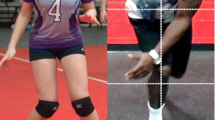Abstract.
The purpose of our examinations was to determine whether gait analysis can provide evidence of functional deficits in patients with surgically treated ruptures of the Achilles tendon, and whether measurable parameters for rehabilitation result. In a retrospective study, we examined 30 patients with traumatic Achilles tendon rupture who had been surgically treated immediately posttraumatically with direct tendon suturing between May 1996 and November 1999. We used gait analysis and applied the Hannover Achilles tendon score with regard to occupational and athletic disability. The average follow-up examination interval was 24 (range 18–28) months. After processing results and placing patients in deficit-oriented therapy, a final assessment was conducted using the score mentioned above and a gait analysis. Prior to beginning deficit-oriented therapy, the 100-point score showed that, after an Achilles tendon rupture, 66.7% of the patients had a good to very good outcome. Gait analysis indicated significant deficits in functional mobility during the swing phase, manifesting as a diminishment of the active heel lift. At the time of the final assessment, the findings from gait analysis demonstrated that these deficits were no longer evident to any significant extent. The 100-point score from the final assessment yielded an increase in good and very good results to a total of 80.0%. Gait analysis is suited to both the detection of functional deficits following reconstructive surgery on the musculoskeletal system and to devising individual, patient-oriented rehabilitation plans.
Résumé.
Nos études avaient pour objet de rechercher si l'analyse instrumentale de la marche était en mesure de mettre en évidence des déficits fonctionnels chez des patients traités chirurgicalement pour une rupture du tendon d'Achille, et si la rééducation pouvait en tirer des bénéfices mesurables. Les examens rétrospectifs de suivi concernent, 30 patients traités chirurgicalement par suture, immédiatement après leur accident, entre Mai 1996 et Novembre 1999, après rupture traumatique du tendon d'Achille. Ces examens ont été effectués par analyse de la marche et sur des critères d'évaluation définis à Hanovre pour le tendon d'Achille, avec prise en compte des déficiences professionnelles et sportives. L'âge moyen des patients de l'échantillon, composé de 6 sujets féminins et de 24 sujets masculins était de 35,6 ans (de 25 à 45 ans). Les examens de suivi se sont déroulés sur un intervalle moyen de 24 mois (de 18 à 28 mois). Après exploitation du résultat et orientation des patients vers une rééducation fonctionnelle, un bilan fut effectué sur les critères mentionnés précédemment et une analyse de contrôle de la marche. L'évaluation sur 100 points après rupture du tendon d'Achille conclut, avant rééducation, à des résultats bons à très bons chez 66,6% des patients. L'analyse instrumentale de la marche mettait en évidence un déficit significatif de la mobilité de l'articulation du pied en phase d'élan. Ce déficit portait sur une diminution de la course active du talon. Au moment du bilan final, les instruments ne permettaient plus de mettre en évidence de façon significative ce déficit. Le bilan final de l'évaluation sur 100 points conclut à des résultats bons à très bons pour 80,0% des sujets de l'échantillon. L'analyse de la marche est tout aussi adaptée aux bilans fonctionnels après intervention réparatrice sur l'appareil locomoteur, qu'à la mise de point de protocoles thérapeutiques personnalisés pour chaque patient.
Similar content being viewed by others
Author information
Authors and Affiliations
Additional information
Electronic Publication
Rights and permissions
About this article
Cite this article
Follak, N., Ganzer, D. & Merk, H. The utility of gait analysis in the rehabilitation of patients after surgical treatment of Achilles tendon rupture. Eur J Orthop Surg Traumatol 12, 90–95 (2002). https://doi.org/10.1007/s00590-002-0020-y
Received:
Accepted:
Published:
Issue Date:
DOI: https://doi.org/10.1007/s00590-002-0020-y




